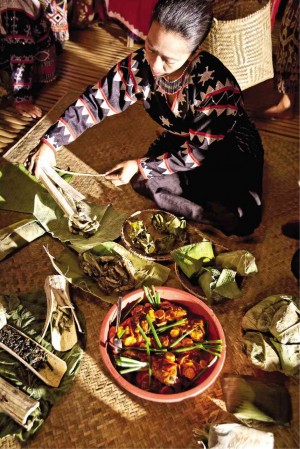
It’s no longer rude to take a photo of your food. Everyone seems to be doing it nowadays, the photos posted online as a document on what people are eating.
Very few, however, take note of what ingredients make up the dish, why it tastes like it does, or how it is cooked.
Renowned photographer Neal Oshima likes to ask about the subject he is shooting. He wants to know about farming methods, tries to connect ingredients to history, inquires how the food being cooked is part of tradition and culture.
The opportunity to tell the underlying stories of his food photographs was presented to Oshima by the Filipino Heritage Festival Inc., headed by Mita Rufino. The exhibit, “Pagkaing Filipino,” will be one of the more interesting activities this May, declared as Heritage Month every year.
The exhibit, which will feature about 50 photographs—a miniscule amount in Oshima’s collection since he has traveled to almost every part of the country—will be at the Museum of the Filipino People, at the Reception Room of the fourth floor, and will run from May 2 to Aug. 2.
‘Balikutsa’
Oshima showed me a close-up photo of balikutsa, the sugar candy produced in Ilocos Sur; he told me how a whole community in Santa Maria grew the sugar cane, pressed the juice out that was cooked in huge vats over wood fire, and reduced the juice to a taffy.
The taffy is then pulled and stretched, and every balikutsa piece from it formed by hand into the beautiful shape it has, like that curly design (volute) on top of a Grecian pillar.
Cooks in the photos are sometimes obscured by the haze of smoke as they go about their work. When Oshima asked an Ilocano kusinero what is being cooked in the vat one early morning, he was told it was ladek, much like Pampanga’s sisig. Here was something new I learned about Filipino cooking.
Most artistic cook
But the most artistic cook, said Oshima, was a T’boli woman who prepared her tribe’s welcome meal. She looked like she was dancing as she prepared the ingredients. The native wear she donned and the ingredients in the pot created brilliant colors.
Ingredients are much more than what go into a dish. An early sample Oshima sent was of newly harvested corn in summer colors. Remember, he said, corn came from Central America, brought by Spain to the Philippines through the galleon trade.
Sometimes, the photographer comes across good subjects by chance. In Kalibo, Aklan, he saw the Aklan Filipino Bakery and asked if he could take photos of the breads and the old pugon
or wood-burning oven.
The owners were kind enough to let him in, and he was also told how a big flood had ruined the oven, but it has been rehabilitated to bake the traditional breads that are part of the locals’ daily diet.
‘Lechon’ cookout
Oshima loves lechon, which is why he has more than one picture of the roasted pig, from the preparation to the cooking. He documented a big lechon cookout in Bukidnon, where four cows and a dozen pigs were roasted for about 300 guests, most of them datu and bae, men and women leaders of the tribes there.
It is the fresh food market which can give a food writer or a photographer so much material about the cuisine of the place—the ingredients favored, the specialties, and those who provide the food such as the sellers, the butchers, the dealers. One can find much local color, as well as enjoy the characters in the market and hear the language of the place.
Oshima showed photographs of the Baguio public market before it was remodeled; it brought back memories of strawberries packed in shoe boxes and those stalls that sold lechon and longganisa.
“Pagkaing Filipino” is not Oshima’s first photography exhibit. He has had several at different galleries: children at play (Silverlens Gallery, Makati City), Philippine garments (Sepia International Gallery, New York) and hair landscapes (Alliance Française, Makati City). He has a master’s degree in fine art photography from the California State University.
The exhibit has excellent photography, but Oshima wanted the stories told in the captions that both he and I provided. We worked together for the first time on the book “Philippine Cuisine: A Nation’s Heritage,” then for “Kulinarya: A Guidebook to Philippine Cuisine” and “Inside the Southeast Asian Kitchen: Foodlore and Flavors.”
Food writing seminar
“The Power of Pen,” the fourth in a series of seminars on food writing, has added travel and lifestyle writing to its lineup, to help promote tourism. Speakers include Felice Sta. Maria, Cora Alvina, Nancy Reyes Lumen, Joseph Cortez, Spanky Enriquez, Ige Ramos, Marilen Fontanilla and yours truly.
Subjects include writing for publications, books and social media, and how cooking demos and editorial design can promote Filipino cooking. Organized by Stramm Inc., the seminar will be held on May 8 and 9 at the TopShelf room of Fully Booked in Bonifacio Global City.
For more information, e-mail stramm_events@yahoo.com or call 9277208, 9276206 and 3523187.
E-mail pinoyfood04@yahoo.com.